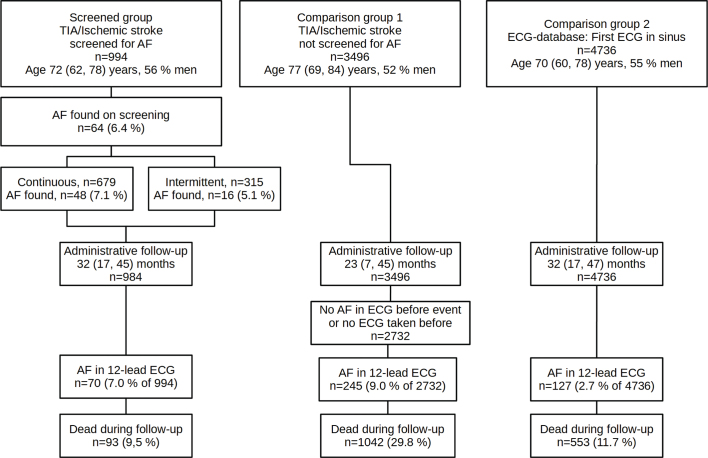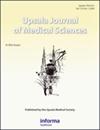间歇性21天心电图监测和连续7天霍尔特记录对994例脑血管事件患者阵发性心房颤动的检测
IF 1.6
4区 医学
Q2 MEDICINE, GENERAL & INTERNAL
Upsala journal of medical sciences
Pub Date : 2022-05-05
eCollection Date: 2022-01-01
DOI:10.48101/ujms.v127.8318
引用次数: 1
摘要
背景:阵发性心房颤动(AF)的检测在卒中护理中具有重要意义。使用的方法是连续心电图(ECG)监测或在一段较长时间内多次短心电图记录。它们的相对效率是一个有待讨论的问题。在一项对994例缺血性卒中或短暂性脑缺血发作(TIA)患者的回顾性队列研究中,我们比较了连续7天监测和连续3周用手持设备记录60秒的间歇性记录。我们将结果与随后在12导联心电图记录中检测到的房颤的发生联系起来。方法:在当地心血管调查数据库中对患者进行鉴定。他们的临床概况和随访期间的生命状况从瑞典卒中登记处和瑞典一般人口登记处获得。为了进行比较,我们使用了年龄和性别匹配的人群,没有已知的脑血管事件和未筛查的脑血管事件。结果:连续筛查检出率为7.1%,间歇筛查检出率为5.1% (P = 0.3)。随访32个月,12导联心电图房颤发生率为7.0%。在筛查阳性亚组中,46.3%的患者发生房颤,而筛查阴性亚组为6.7% (P < 0.0001)。结论:尽管间歇监测组具有更有利的临床表现,但两种筛查方法的心律失常发生率相似。随访期间,心电图筛查阳性对房颤有较高的预测作用。本文章由计算机程序翻译,如有差异,请以英文原文为准。

Detection of paroxysmal atrial fibrillation in 994 patients with a cerebrovascular event by intermittent 21-day ECG-monitoring and 7-day continuous Holter-recording.
Background The detection of paroxysmal atrial fibrillation (AF) is of importance in stroke care. The method used is continuous electrocardiogram (ECG)-monitoring or multiple short ECG-recordings during an extended period. Their relative efficiency is a matter of discussion. In a retrospective cohort study on 994 patients with an ischemic stroke or transient ischemic attack (TIA), we have compared continuous 7-day monitoring to intermittent recording 60 sec three times daily with a handheld device during 3 weeks. We related the result to subsequent occurrence of AF as detected in 12-lead ECG recordings. Methods The patients were identified in the local database of cardiovascular investigations. Their clinical profile and vital status during the follow-up were obtained from the Swedish Stroke Register and the Swedish general population registry. For comparison, we used an age- and sex-matched population with no known cerebrovascular event and a population with a cerebrovascular event that was not screened. Results AF was detected in 7.1% by continuous screening and in 5.1% by intermittent screening (P = 0.3). During follow-up of 32 months, AF in 12-lead ECG was found in 7.0%. In the subgroup with positive screening, 46.3% had AF compared with 6.7% in the subgroup with negative screening (P < 0.0001). Conclusions The two screening approaches had a similar yield of arrhythmia, in spite of the group with intermittent monitoring having a more favorable clinical profile. A positive screening was highly predictive of AF in ECG during the follow-up.
求助全文
通过发布文献求助,成功后即可免费获取论文全文。
去求助
来源期刊

Upsala journal of medical sciences
医学-医学:内科
CiteScore
5.60
自引率
0.00%
发文量
31
审稿时长
6-12 weeks
期刊介绍:
Upsala Journal of Medical Sciences is published for the Upsala Medical Society. It has been published since 1865 and is one of the oldest medical journals in Sweden.
The journal publishes clinical and experimental original works in the medical field. Although focusing on regional issues, the journal always welcomes contributions from outside Sweden.
Specially extended issues are published occasionally, dealing with special topics, congress proceedings and academic dissertations.
 求助内容:
求助内容: 应助结果提醒方式:
应助结果提醒方式:


